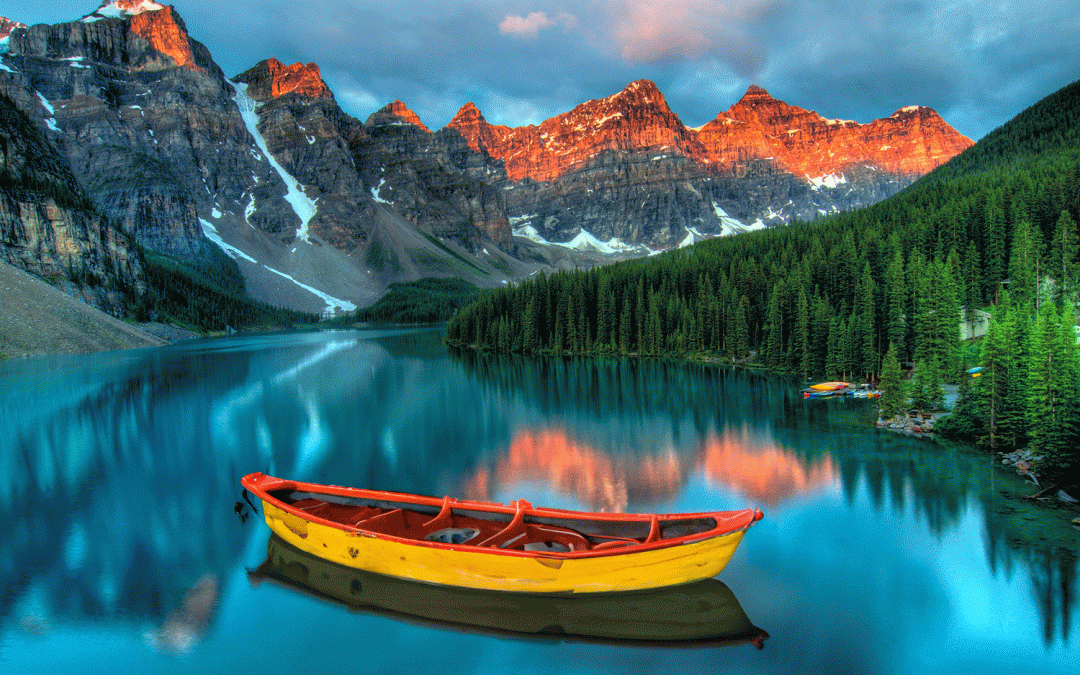Uncovering the Magic of Yellowstone National Park
Sprawling across three states in the United States – Wyoming, Montana, and Idaho – lies Yellowstone National Park, the world’s first national park. This natural treasure is a testament to the power and beauty of wilderness, offering mesmerizing landscapes, diverse wildlife, and an array of outdoor activities.
Discovering Yellowstone’s Wonders
Yellowstone National Park, spanning the states of Wyoming, Montana, and Idaho, is a natural wonderland that captivates visitors with its breathtaking landscapes and unique geothermal features. The park is home to over half of the world’s geysers, with Old Faithful being the most iconic. This geyser derives its name from its predictable eruptions which occur approximately every 90 minutes, shooting boiling water high into the air in a spectacular display of nature’s power.
Another of Yellowstone’s wonders is the Grand Prismatic Spring, the largest hot spring in the United States. Its vivid rainbow colors, caused by bacteria living around the edges of the mineral-rich water, create a sight so beautiful it almost seems surreal. The spring’s deep azure center contrasts starkly with its orange and red fringes, making it one of the park’s most photographed features.
In addition to its geothermal marvels, Yellowstone is also a wildlife enthusiast’s paradise. It’s one of the few places in the U.S. where you can see wild grizzly bears, wolves, and herds of bison and elk in their natural habitat. The park’s Lamar Valley is often referred to as the “Serengeti of North America” due to its abundant wildlife.
However, the wonders of Yellowstone are not just above ground. The park sits on one of the world’s largest active volcanic systems. This subterranean volcano, known as the Yellowstone Caldera, is responsible for much of the park’s geothermal activity. While it’s an intimidating thought, the chance of an eruption in our lifetime is exceedingly low. In the meantime, it provides a fascinating glimpse into the fiery forces that shaped and continue to shape our planet.
When to Visit and Entrance Fee
When planning a visit to Yellowstone National Park, it’s important to consider the time of year as each season offers unique experiences. Spring, from April to June, is a wonderful time to see baby animals and blooming wildflowers. The weather can be unpredictable, but the park is less crowded, offering a more peaceful exploration of its wonders.
Summer, from July to August, is the most popular time to visit Yellowstone. The weather is typically warm and all the park’s facilities are open. It’s the perfect time for hiking, fishing, and camping. However, due to its popularity, it’s also when the park is most crowded, so advanced reservations for accommodations and campsites are highly recommended.
Fall, from September to November, brings cooler temperatures and changing colors as the park’s flora prepares for winter. Wildlife is more active as animals get ready for winter, making it an excellent time for wildlife viewing. Winter, from December to March, transforms Yellowstone into a snow-covered wonderland. It’s a great time for snowshoeing, cross-country skiing, and guided snowmobile tours.
As for the fees, entrance to Yellowstone National Park is $35 per vehicle, which covers all passengers and is valid for seven days. If you’re entering by foot, bicycle, or motorcycle, the fee is $20 per person. For frequent visitors, an annual pass is available for $70, providing unlimited access to the park for a year. Remember, these fees go towards the preservation and maintenance of this magnificent national park, ensuring it can be enjoyed by generations to come.
Rules and Safety in Yellowstone
Exploring Yellowstone National Park is an unforgettable experience, but it’s crucial to adhere to park regulations to ensure both your safety and the preservation of this natural wonder. One of the most important rules involves wildlife. Visitors must maintain a safe distance from animals at all times. This means staying at least 100 yards away from bears, wolves, and nesting birds, and 25 yards away from all other animals. It’s important to remember that these animals are wild and can be unpredictable, so it’s essential to respect their space.
In addition to maintaining a safe distance, visitors should never approach, harass, or feed animals. Feeding wildlife not only endangers you and those around you but can also harm the animals themselves, affecting their natural behaviors and potentially leading to conflicts with humans. If you encounter a bear, it’s important not to run, and avoid direct eye contact, which could be perceived as a threat.
Yellowstone’s geothermal areas also require caution. Visitors must stay on boardwalks and designated trails when exploring these regions. The ground in hydrothermal areas can be fragile and thin, and there’s boiling water just below the surface. Straying from marked paths can lead to dangerous, even fatal, accidents. Pets are also prohibited in these areas for their safety.
Lastly, hunting is strictly prohibited within the park. Yellowstone is a sanctuary for numerous species, many of which are protected or endangered. Respect for all park rules and regulations ensures that Yellowstone remains a safe and enjoyable place for all its visitors and a secure habitat for its remarkable wildlife.
Where to Stay in Yellowstone National Park
Staying in Yellowstone National Park is an experience like no other. The park offers a variety of accommodations to suit different preferences, from rustic campgrounds to comfortable lodges. There are twelve campgrounds with over 2,000 sites for those who prefer an authentic wilderness experience. If you’re looking for more comfort, the park has nine lodges with hotel-style rooms. It’s important to note that accommodations can fill up quickly, especially during the summer months, so it’s recommended to make reservations well in advance.
When packing for your stay in Yellowstone, consider the activities you plan to do and the time of year. Always pack layers as temperatures can fluctuate greatly throughout the day, and even in the summer, nights can be chilly. A rain jacket is essential as the weather can change rapidly. Hiking boots are advised for those planning to explore the park’s extensive trail system. Don’t forget essentials like sunscreen, a hat, and sunglasses to protect against the sun.
For camping, you’ll need to bring all necessary gear including a tent, sleeping bag, cooking equipment, and food storage containers. Remember, Yellowstone is bear country, so all food and scented items must be kept sealed and stored in bear-resistant containers or hard-sided vehicles to prevent attracting wildlife to your site. Campfires are allowed only in established fire pits in order to prevent forest fires.
If you’re staying in one of the park’s lodges, amenities such as bedding, towels, and basic toiletries are typically provided. However, it’s a good idea to bring any additional comfort items you may want, such as a favorite pillow or extra blanket. Most lodge rooms do not have televisions, radios, or Internet service, reinforcing Yellowstone’s emphasis on connecting with nature. Whether you’re sleeping under the stars or in a cozy lodge room, staying in Yellowstone National Park provides countless opportunities to immerse yourself in the beauty of the natural world.
Potential Dangers in Yellowstone
Yellowstone National Park is a place of immense natural beauty, but it also poses certain risks that visitors should be aware of. One of the most significant dangers in the park is wildlife. Yellowstone is home to a variety of wild animals including bears, wolves, bison, and elk. These animals are wild and unpredictable and can pose a threat if approached or provoked. It’s crucial to maintain a safe distance and never feed or approach wildlife.
Another danger comes from the park’s geothermal features. Yellowstone has more than 10,000 thermal features, including geysers, hot springs, and mud pots. While beautiful, these features can also be dangerous. The water in geysers and hot springs can reach temperatures high enough to cause severe or even fatal burns. Visitors must stay on designated paths and boardwalks, and children should be closely supervised at all times.
Weather in Yellowstone can also present challenges. Rapid weather changes can occur, and conditions can become hazardous, particularly during winter months when heavy snowfall and extremely cold temperatures are common. Hypothermia and frostbite are real dangers, and roads can become icy and treacherous. Make sure to check weather forecasts regularly and prepare appropriately.
Finally, while hiking, visitors should be aware of the risk of getting lost. Yellowstone covers over 2.2 million acres, with many miles of trails. It’s easy to lose your way if you stray off marked trails. Always carry a map and compass, let someone know your planned route and expected return time, and have enough food and water for your trip. By being prepared and respectful of the park’s rules and nature, visitors can ensure a safe and enjoyable trip to Yellowstone National Park.
Professional Photography and Flying a Drone in Yellowstone National Park
Yellowstone National Park is known for its breathtaking landscapes, making it a desirable location for hobbyists, commercial photographers, and videographers. However, there are strict regulations in place to protect the park’s natural environment and the safety of its visitors.
One of the most stringent rules pertains to the use of drones. Flying drones, whether for recreational or commercial purposes, are prohibited within the boundaries of Yellowstone National Park. This rule is in place to prevent disturbances to wildlife and to maintain the peace and tranquility of the park. Drones can be disruptive, potentially causing stress to animals and spoiling the experience for other visitors. Violation of this rule can result in hefty fines, confiscation of equipment, and even jail time.
For commercial photographers, a permit is required for filming or photography within the park. These permits are issued to ensure that the activities do not harm the park’s resources or disrupt visitor enjoyment. It’s important to note that commercial photography includes not only traditional photo shoots for products or services but also certain types of filming, such as documentaries or educational materials.
While these rules may seem restrictive, they are in place to preserve the integrity of Yellowstone National Park. The park is a sanctuary dedicated to the protection of unique geologic features, diverse wildlife, and pristine landscapes. By respecting these regulations, photographers and visitors alike can help ensure that Yellowstone remains a place of natural beauty for generations to come.
In Conclusion, Yellowstone National Park is a world of wonder waiting to be explored. With its breathtaking landscapes, abundant wildlife, and thrilling outdoor activities, it promises an unforgettable adventure into the heart of nature’s majesty. Find out more about USA Tourist destinations.

